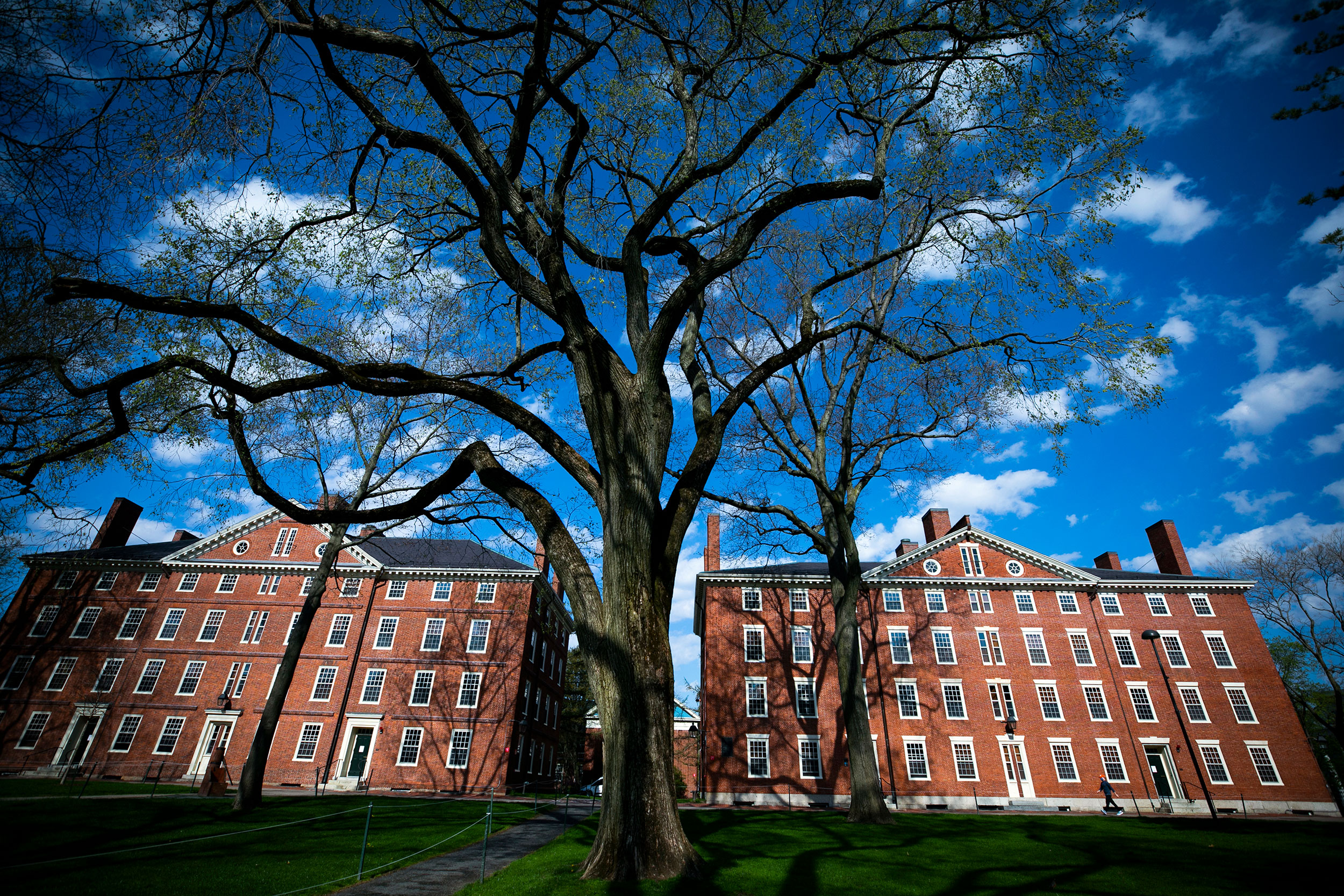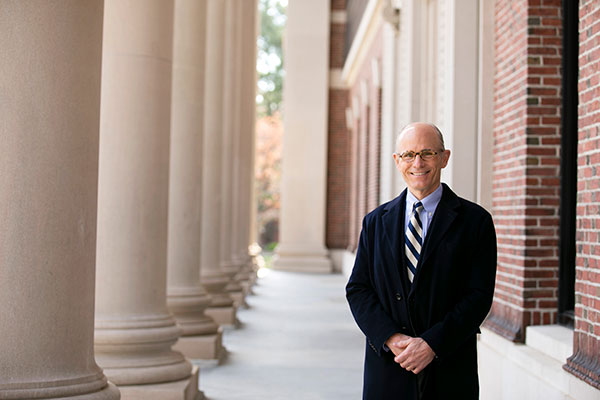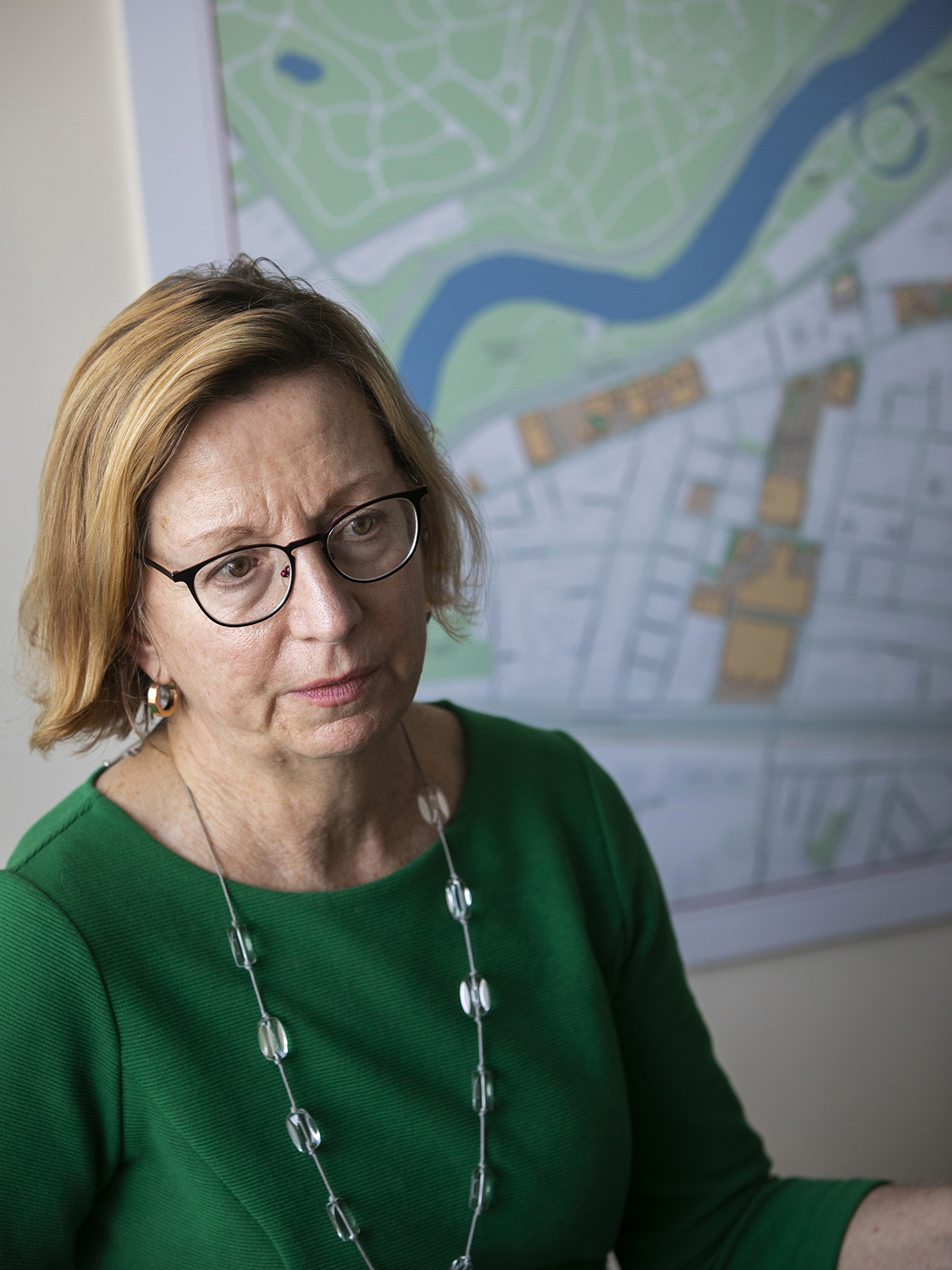
Campus-wide support was key to the University realizing a budget surplus amidst declining revenue.
Stephanie Mitchell/Harvard file photo
University reports budget surplus despite pandemic challenges
Long-term planning playbook, strategic School leadership bolstered annual financial results
Harvard ended last fiscal year with a budget surplus despite unprecedented challenges brought on by the COVID-19 pandemic, which included a second year of declining revenue, a result not seen since the Great Depression, and significant increases in spending to keep the community safe, according to the University’s annual financial report released today.
The Gazette spoke with Executive Vice President Katie Lapp and Chief Financial Officer and Vice President for Finance Thomas Hollister to learn more about how the University’s performance got a boost from long-term planning, leadership at the School level, and the commitment of so many within the community to Harvard’s mission to teaching and learning. This interview was edited for clarity and length.
Q&A
Katie Lapp and Thomas Hollister
GAZETTE: How did the University manage to produce a healthy $283 million surplus on a $5.2 billion budget during such a difficult period after running a $10 million operating deficit the year before?
LAPP: The University was prepared to handle a crisis prior to COVID-19 — even though the pandemic was unprecedented in many ways — due to the planning put forth by Tom and his team and the Financial Administration Department, with the support of the Corporation Finance Committee. Together, they created a recession playbook in 2019, which was designed to study how Harvard reacted to the economic downturn of 2008, in order to ready itself for the next recession.
This playbook challenged leadership in the Schools and units across Harvard to think creatively about how we could, together, continue to support Harvard’s commitments to teaching and research in case such a financial downturn might take place. This was such a critically important exercise, and I don’t think we’d be where we are today, with this financially healthy outlook, without it.
Importantly, so many Harvard community members have stepped up over the past 20 months in support of this planning, through resourcefulness, sacrifice, resilience, and again, a true commitment to Harvard’s mission.
“This commitment went beyond merely preventing widespread furloughs and layoffs, as we were able to provide nearly $60 million in compensation and benefits continuity to more than 2,800 Harvard employees and contract workers whose work was either partially or fully displaced due to the pandemic,” said CFO and Vice President for Finance Thomas Hollister.
Stephanie Mitchell/Harvard Staff Photographer

HOLLISTER: The community rallied in remarkable ways. Our revenues declined in FY2021 for the second year in a row, the first time this has happened at Harvard since the Great Depression, and at the same time, new costs were incurred; the University spent about $83 million in FY2021 on COVID-19-related spending alone in order to keep our community safe, on testing, contact tracing, isolation and quarantine measures, and on lab equipment, supplies, and staffing.
Yet these losses and additional expenses were largely offset thanks to cost-cutting measures on such things as travel, capital projects, supplies, equipment, food, consultants, energy, and maintenance and repairs. Compensation costs were also lowered due to the voluntary early retirement program as well as salary and hiring freezes.
We also benefited from the extraordinary support of Harvard’s loyal alumni and donors, who provided gifts for, in many cases, immediate use. Through their support, we were able to support students by granting admission deferrals, increasing per-student levels of financial aid and scholarships, waiving graduate housing rental contracts, and eliminating work-study requirements.
Throughout the pandemic, we have stayed true to the framework for making financial decisions that was shared with the Harvard community back in April of 2020 by Katie, President Bacow, and Provost Garber, which is: prioritize the health and safety of students, faculty, and staff; do everything we can to maintain the excellence of Harvard’s educational and research mission; and recognize that the strength of Harvard is its people.
GAZETTE: This past spring we talked about a Chronicle of Higher Education report showing that 650,000 jobs were eliminated in higher education in a period of 12 months — or one out of every eight jobs in the sector. Tom, you reminded us that compensation costs were lowered during the pandemic due to the voluntary early retirement program, salary and hiring freezes, yet Harvard, unlike many of the nation’s institutions of higher education, was able to avoid any widespread furloughs or job layoffs. How has the University managed to do this?
HOLLISTER: Again, I would reference the commitment University-wide to control costs. And, remarkably, this commitment went beyond merely preventing widespread furloughs and layoffs, as we were able to provide nearly $60 million in compensation and benefits continuity to more than 2,800 Harvard employees and contract workers whose work was either partially or fully displaced due to the pandemic.
It’s important to point out, too, that Katie’s team, the University Health Services led by Dr. Giang Nguyen, and so many others across the University have been instrumental in keeping people at work and healthy, despite the unprecedented challenges to work and life brought on by the pandemic. Workplace policies enabled employees to work from home; emergency relief grants were provided to employees facing economic hardship; paid time off was expanded for employees needing to care for family members who may have been in need of care; and new health and wellness programs were established to help community members cope with the new, difficult realities of living and working during COVID-19.
GAZETTE: Could you talk more about how leadership in Harvard’s Schools and units was so instrumental in getting to where we are today?
HOLLISTER: I’ve said this before, but I think it’s important to underscore that the University’s surplus is a consolidation of the Schools’ and units’ results. So, it’s the deans and department heads who make the decisions about how to invest those monies or whether to set them aside in rainy-day reserves. Over the past 20 months, they were the ones who were analyzing the impact of COVID-19 locally in order to ensure that resources continued to be used to best support Harvard’s primary commitment to teaching and research, while keeping the community safe. The University also made available one-time resources to assist deans in providing additional support across our Schools, a step intended to ensure progress throughout the University.
There is so much happening across campus. Here are just as a few examples of how Harvard’s Schools and units continued to innovate in teaching and research to address the most pressing issues of our day, as well as support our community during these times:
- The Harvard T.H. Chan School of Public Health launched a program for business leaders to provide them with the foundational tools of public health.
- Harvard Business School announced the Action Plan for Racial Equity, a comprehensive plan to advance racial equity both within and beyond the School.
- The Faculty of Arts and Sciences unveiled a robust anti-racism agenda that prioritized six areas of action.
- The Graduate School of Design launched “GSD Now,” a digital platform intended to provide the community with access to the full breadth of activity happening across the School at any given time.
- The Harvard Medical School Therapeutics Initiative started up the Ideation Hub, a sweeping, School-wide endeavor to advance fundamental scientific discovery, help translate discoveries into medicines, and craft new educational paradigms for therapeutics education.
- The Harvard School of Dental Medicine invested in the Harvard Dental Center in Cambridge, to provide two locations of service.
- And groups within Wyss leveraged 3D printers to prototype and produce face shields that led to a regional, scalable personal protective equipment production of up to 400,000 products per day.
I could go on and on.
LAPP: These examples make the strong point that, even during the pandemic, when we did have to make significant decisions about cost-cutting, the Schools and units were given discretion to make decisions relevant to their needs. So many community members were able to pivot very quickly and create new opportunities. It’s really impressive to be able to implement positive thinking and make progress on certain priorities, despite having fewer resources. And this is a testament to the incredible leadership in the Schools and units, across Harvard.
And we made progress on major capital projects across campus during this challenging period. Of course, the completion of the University’s Science and Engineering Complex building, home to the Harvard John A. Paulson School of Engineering and Applied Sciences, was also a major accomplishment completed amid the COVID-19 pandemic. The SEC came online in fiscal year 2021, opening its doors to students this fall. This 544,000-square-foot complex has been certified as one of the healthiest, most sustainable, and energy-efficient laboratories in the world. There is so much excitement around this incredible new complex; the energy is palpable when you’re in the building.
At Harvard Divinity School, enabled by a major gift, Swartz Hall opened this summer after an extensive renovation, which includes a new, modernized, inclusive, multifaith space. And renewal of the College’s undergraduate residences in the River District continues at Adams House’s Randolph Hall; while Adams’ Claverly Hall and Apthorp House were recently completed.

GAZETTE: Let’s turn our attention to the endowment, which had a very good fiscal year. In fact, endowments across the country did very well due to the strength of the markets over this time period.
HOLLISTER: That’s right. Here at Harvard, thanks in large part to the Harvard Management Company, the endowment enjoyed an outstanding year. In fiscal year 2021, the return on the endowment was 33.6 percent and its value increased from $41.9 billion at the end of fiscal year 2020 to $53.2 billion at the end of fiscal year 2021.
GAZETTE: Of course, among university and college endowments, Harvard frequently attracts considerable attention due to its endowment size. What else should we know about the endowment?
HOLLISTER: Certainly Harvard is relatively well-resourced compared to many other universities, but contrary to popular perception, the University does not have unlimited wealth. It’s true that our endowment is sizeable on an absolute basis, but it is largely made up of individual funds that are committed to specific purposes, based on the legal terms agreed to when gifts were made to the University or one of our Schools. This means these funds are committed to supporting specified existing vital academic programs and campus activities and can’t simply be diverted for other purposes. In short: Every penny of the annual distribution from the endowment is subscribed and utilized in support of our mission, with the two largest categories of use being financial aid for undergrads, graduate fellowships, student life and activities, and faculty salaries, including professorships.
Harvard distributes as much as it responsibly can from the endowment to benefit both current and future generations of students and scholars. As a result, the endowment can provide the University’s financial foundation for years to come.
Of note: As we announced in April, based on the fiscal-year-to-date performance of the endowment at that time, the Corporation increased the distribution from a 1 percent increase to a 2.5 percent increase, toward providing more funding for all endowed activities. The increase is consistent with Harvard’s intention to distribute as much of the endowment’s earnings into operations as it responsibly can every year in order to fund academics and research, and we remain committed to this increase in the year to come.
GAZETTE: Looking ahead, how is the University financially positioned to emerge from the pandemic?
HOLLISTER: Let me first acknowledge that this past year was a year of difficulty and sacrifice for everyone. Thanks to the stewardship by all members of the Harvard community, who pulled together to manage resources wisely, we are in a better position to continue to, through teaching and research, pursue solutions to some of the pressing and challenging issues of our day, while ensuring that these opportunities will exist for future generations.
LAPP: Having worked with virtually every level of the University over the last 20 months, and understanding just how much people gave of their energy and time, while they were dealing with very real challenges at home, instances of hardship, heartbreak, and loss, it’s just stunning how, through all of this, everyone rose to the occasion.
There is a bright future for Harvard, and it’s because of our students, faculty, staff, and researchers, who will continue to be a part of our positive momentum forward. I could not have been prouder about how our community came together to get us to the point where we are today.




